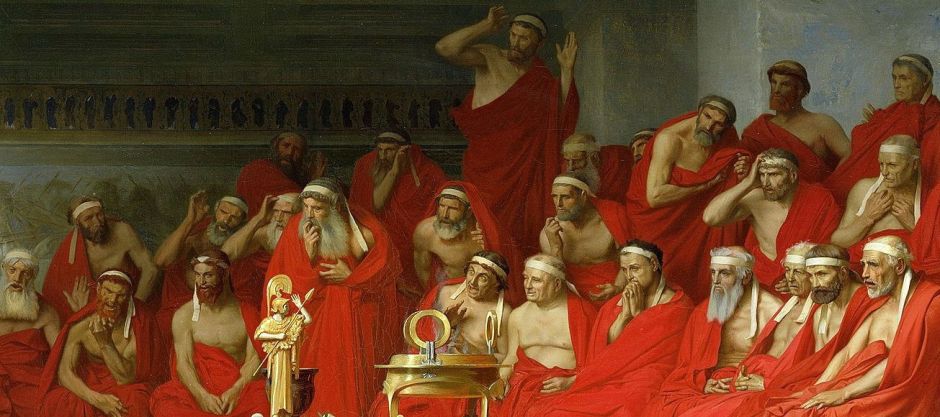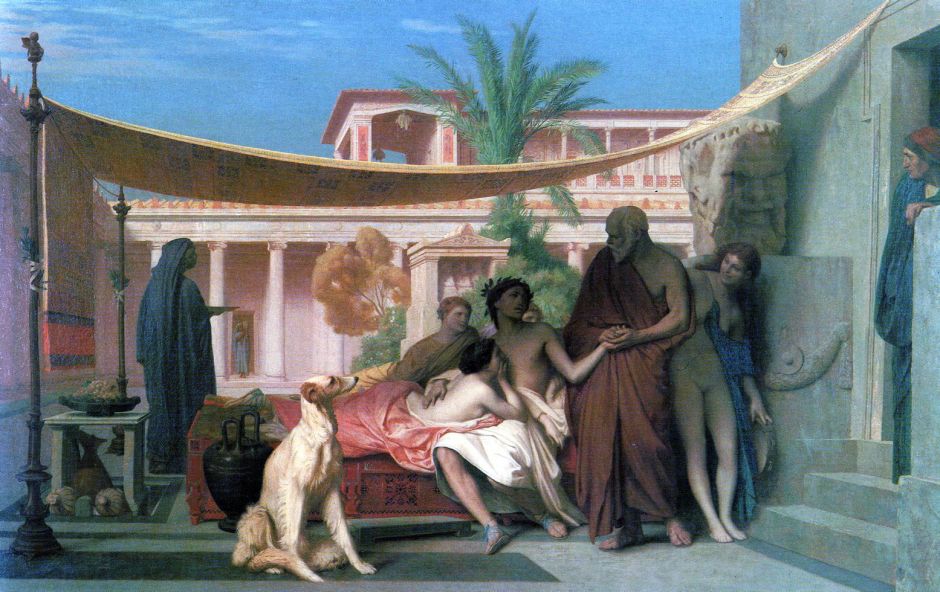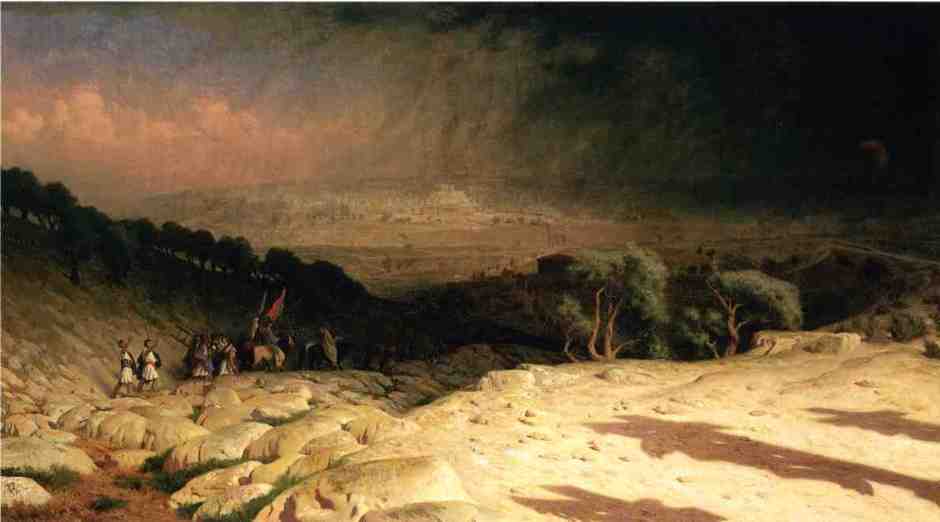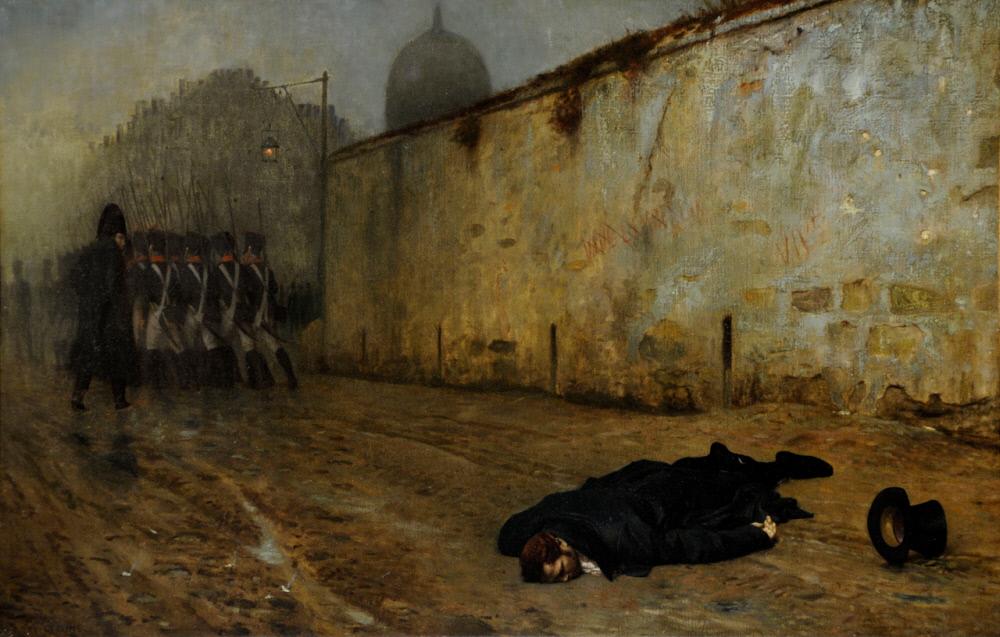After his series of paintings with major classical themes, in 1861 Jean-Léon Gérôme changed again, with three works concerning themselves with prostitution. It’s worth remembering in this context that Manet completed his Le Déjeuner sur l’Herbe in 1863, usually read as depicting contemporary prostitution in Paris, a work refused by the Salon and exhibited in the Salon des Refusés that year.

Phryne was a highly successful and very rich courtesan (hetaira) in ancient Greece who, according to legend, was brought to trial for the serious crime of impiety. When it seemed inevitable that she would be found guilty, one of her lovers, the orator Hypereides, took on her defence. A key part of that was to unveil her naked in front of the court, in an attempt to surprise its members, impress them with the beauty of her body, and arouse a sense of pity. The legend claims that this ploy worked perfectly.

Phryne is to the left of the centre, in the midst of the semicircular court, completely naked apart from some jewellery on her neck and wrists, and her sandals. She is turned away from the gaze of the judges, her eyes hidden in the crook of her right elbow, as if in shame and modesty. Behind her, to the left, her defence has just removed her blue robes with a flourish, his hands holding them high.
At Phryne’s feet is a gold belt of a kind worn to designate courtesans in France from the thirteenth century, with the Greek word ΚΑΛΗ (kale), meaning beautiful.

The judges, all men with bare chests and wearing uniform scarlet robes, are taken aback. Gérôme shows a whole textbook of responses from pure fright, to anguish, grief, and disbelief, with each of those men looking straight at Phryne. The artist also follows an ancient colour coding scheme, in which the flesh of women is pale, almost white, in contrast to the more sallow skin of men.
Superficially, it’s easy to presume that Gérôme was using Phryne’s nakedness to appeal to the lowest desires, which remained one of the popular attractions of the annual Salon. However it’s more likely that this is a statement about attitudes to the nude female form and the judgement of the Salon. The timing of Gérôme’s narrative moment is far more conventional, conforming as it does to Aristotle’s peripeteia and the novelist’s moment of surprise.
This was exhibited at the Salon of 1861, and at the Exposition Universelle in Paris in 1867, but critics like Émile Zola were harsh in their judgement, dismissing it as “antique rubbish”. Perhaps they also missed its compositional similarity to images of art students painting in a life class.

In his other narrative painting of that year, Gérôme told the story of a Greek statesman and general who in his youth used to sneak off and consort with courtesans: Socrates seeking Alcibiades in the house of Aspasia (1861). A pupil of Socrates, who appears to have had a pederastic relationship with the young Alcibiades, it was the philosopher who came and dragged his charge away from the clutches of Aspasia and her friends. According to classical accounts, Alcibiades was so attracted to courtesans that he continued to enjoy their company after he married, which unsurprisingly led to his wife to try to divorce him.
Gérôme’s painting was a commission for Sultan Abdul Aziz, and was exhibited in the Salon of 1861. Two years later, it was sold by Goupil for 12,500 francs.

A year later, it was a more contemporary story of Louis XIV and Molière (1862) that Gérôme committed to canvas. Jean-Baptiste Poquelin, universally known as Molière, was a highly successful playwright who enjoyed the patronage of King Louis XIV.
This is based on a story published in the memoirs of Madam Campan in 1822, in which Molière had been treated with disdain by the courtesans at the royal palace of Versailles. When the king heard this, he invited the playwright to dine with him to impress his court and enhance Molière’s credibility with the courtesans.
Although an apocryphal story of dubious merit, this had been painted by Ingres in 1857. Gérôme’s purpose seems to have been for the greater glory of the Emperor Napoleon III. This painting was exhibited at the Salon in 1863, and sold by Goupil from there for 25,000 francs. It was later exhibited at the Exposition Universelle in Paris in 1867, by which time it was already in American ownership, and in 1923 it was bought by William Randolph Hearst.
Over a period of just three years, from Caesar (1859) to Louis XIV and Molière (1862), Gérôme had swung from the staidly conventional to the highly novel, and had covered the themes of assassination, cynicism, prostitution, and looking. He was at the height of his narrative powers just as the Second Empire was about to turn sour.
In 1863, Gérôme married Marie Goupil, the daughter of Adolphe Goupil, proprietor of the gallery that was flourishing thanks to Gérôme’s paintings.

Gérôme articulated Napoleon III’s aspirations for empire in his elaborate and formal painting of the Reception of Siamese Ambassadors by Napoleon III (1864), depicting a grand reception held at Fontainebleau on 27 June 1861. Gérôme had attended in the role of semi-official court painter (commissioned by the State), made sketches of some of the key figures, and was further aided by photographs made by Nadar. He also included himself, and the older artist Ernest Meissonier (1815-1891), in the painting: I believe that they are both at the back, at the far left.
This work was shown at the Salon the following year, where Degas and Monet exhibited their first paintings.
He continued his theme of empire with a painting of Cleopatra VII Philopator, known more widely as Queen Cleopatra, who had been the last active pharaoh of Ptolemaic Egypt, ruling from 51 to 30 BCE. For much of this period she ruled jointly with relatives; in 51 BCE, when she was ruling with her ten year-old brother Ptolemy XIII, they fell out, and she tried to rule alone.
In 47 BCE, she took advantage of Julius Caesar’s anger towards her brother by having herself smuggled into Caesar’s palace in Egypt, so that she could meet with the emperor. Although she was probably smuggled inside a large bag, this has traditionally and more romantically been described instead as a large roll of carpet. She became Caesar’s mistress, bearing him a son, and convincing him to fight and defeat Ptolemy’s army at the Battle of the Nile, restoring Cleopatra to her throne.

Gérôme depicted this in his Cleopatra before Caesar in 1866. Cleopatra is stood at the edge of the carpet from which she has just emerged, dressed (or undressed) for seduction. She looks at Caesar, her expression hard to read because of the angle of view of her face. Her breasts are exposed below an elaborate Egyptian jewellery collar, and wispy veils hang from a belt-like girdle slung from her hips. A slave cowers behind and to the right of her. Caesar is working at his desk, looking up at Cleopatra, his hands held out as if trying to regain control of the situation. Behind Cleopatra several men, presumably Caesar’s counsel, are sat at a table.
This was shown at the Salon in 1866. At the time, the French diplomat Ferdinand de Lesseps and his company were busy constructing the Suez Canal in Egypt, which opened under French control in 1869.

Gérôme was by his own admission not a religious man, and painted few religious works. Of those Golgotha (Consummatum Est, or Jerusalem) (1867) is striking for its use of the shadows of the crucified, and for its exploration of the play of light, which was to become so central to Impressionism. This was exhibited to acclaim at the Salon of 1868.

Gérôme made several paintings showing the first Emperor Napoleon in Egypt, including this highly detailed and intricate version of General Bonaparte and his Staff in Egypt from 1867. The French Campaign in Egypt and Syria had been in 1798-1801, so this was still relatively recent history, even when viewed from the distance of the final years of the Second Empire, and near-completion of the Suez Canal.
This was also a historically relevant time to be painting the expeditionary successes of the First Empire: Napoleon III had demanded for France the left bank of the Rhine, Luxembourg, and Belgium the previous year, held an Exposition Universelle in Paris for much of 1867, and had been actively pursuing its empire in Mexico, Egypt, and south-east Asia.
The following year, Gérôme courted controversy when he depicted the execution of one of Napoleon I’s leading military commanders, a strongly pro-Empire topic treated in an unconventional way.
Michel Ney (1769-1815) was a leading military commander during the French Revolutionary and Napoleonic Wars, and was made a Marshal of France by Napoleon. Following Napoleon’s defeat and exile in the summer of 1815, Ney was arrested, and tried for treason by the Chamber of Peers. He was found guilty, and executed by firing squad near the Luxembourg Gardens in Paris on 7 December 1815. He refused a blindfold, and was allowed to give the command to fire upon himself.

The Death of Marshal Ney (1868) uses a similar narrative approach to Gérôme’s earlier paintings of the murder of Caesar, in showing a moment after the climax of the story. Ney’s body is abandoned, slumped and lifeless on the muddy ground, his top hat apart at the right edge of the canvas. Behind where he stood but a few moments ago there are half a dozen bullet impact marks on the wall, as the firing squad is being marched off, to the left and into the distance.
Gérôme achieves his narrative using composition and cues such as the bullet marks, alone. Instead of the tense horror of the shots about to be fired, or being fired, as used by Manet and Goya, for example, he opts for this cold, bleak, heartless execution, which is grimly effective. He has painted it as nothing less than a street crime, not an act of justice.
Although the graffiti on the wall are hard to read in this image of the painting, both begin with the word VIVE (‘long live’). The first follows that with the word EMPEREUR (emperor), which has been crossed out, and in the second the subsequent word has been erased altogether. The uncertainty in these may refer to Marshal Ney’s enduring loyalty to Napoleon, but his oath of allegiance to the king when the monarchy was restored in 1814.
This was exhibited at the Salon in 1868, where it became the centre of attention. As a painting, it appears to have been well-received, but its engagement in politics proved more controversial. The rising tide of Republicanism brought fierce debate over the issues raised.
The Second Empire then entered dark days leading to the disastrous Franco-Prussian War in 1870. Gérôme avoided political controversy during this period with a succession of Orientalist works, many from a visit he made to Egypt and Palestine in 1868; he also returned as an official observer to the opening of the canal. Being suitably escapist, they proved popular.
As German forces closed on Paris in 1870, Gérôme fled to London, returned to Paris briefly in the autumn/fall, then went back to London. He finally returned to Paris in June 1871, after the suppression of the Paris Commune. Next came his most famous work, in a return to the gladiators of Rome.
References
Ackerman GM (2000) Jean-Léon Gérôme, Monographie révisée, Catalogue Raisonné Mis à Jour, (in French) ACR Édition. ISBN 978 2 867 70137 5.
Scott Allan and Mary Morton, eds. (2010) Reconsidering Gérôme, Getty. ISBN 978 1 6060 6038 4.
Gülru Çakmak (2017) Jean-Léon Gérôme and the Crisis of History Painting in the 1850s, Liverpool UP. ISBN 978 1 78694 067 4.
de Cars L et al. (2010) The Spectacular Art of Jean-Léon Gérôme (1824-1904), Skira. ISBN 978 8 85 720702 5.

